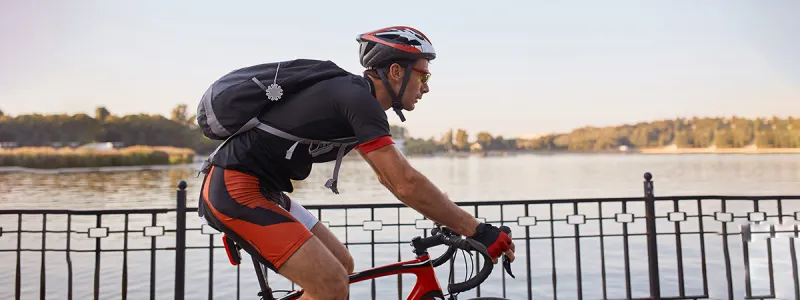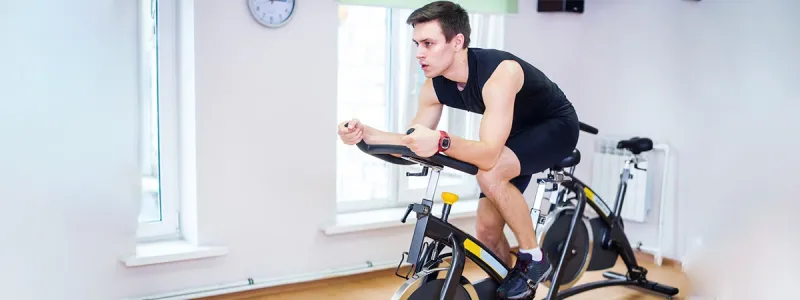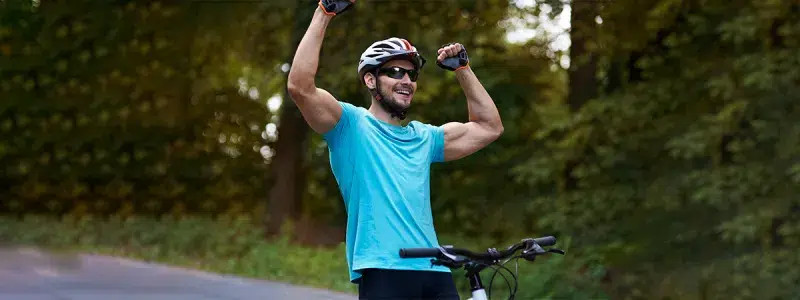Cycling offers a transformative impact on the body, enhancing speed, strength, and cardiovascular endurance. It targets multiple muscle groups, including the lower body, arms, and core. Regular cycling leads to a lean, fit physique with benefits like fat loss, improved heart and lung function, and increased stamina.
Cycling does work the muscles in your arms, but it’s not typically an effective way to make them significantly more prominent. It can help tone your arms. Shifting positions in and out of the saddle during cycling can help strengthen your biceps and triceps.
This blog post explains how cycling can be beneficial to strengthening the arms in these practical ways.
How Does Cycling Make Your Arms Stronger? 7 Key Ways

Your arms also play an essential role in maintaining balance, steering, and providing support and stability during challenging terrain. So, here are some tips that can help you strengthen your arms while cycling.
Engage Your Arms
During cycling, actively engage your arms to improve your upper body strength. This means you straighten and bend your elbows with each pedal rotation while cycling. Performing this exercise will strengthen your triceps, biceps, and shoulders.
Vary Your Hand Positions
Another way to target your arms while cycling is to vary your hand positions while riding. Most bicycles come equipped with multiple hand positions, such as the tops of the handlebars, the hoods, and the drops. By shifting your hands between these positions, you can engage different arm muscles and work them more effectively.
✔ Top Pick: Padded Cycling Gloves
Many people use padded cycling gloves to reduce pressure on the hands and support the arms during long rides.
Hill Climbing
You must engage your arms to support your body weight when cycling uphill. Hill climbing requires a lot of upper body strength because it requires more effort to pedal against gravity. This training challenges your arm and leg muscles, providing a full-body workout.
Interval Training
Interval training is a great way to improve not only your cardiovascular fitness but also your arm strength. During interval training, you alternate between high-intensity pedaling and recovery periods. During high-intensity periods, you use your arms to maintain speed and balance, which in turn makes your arms stronger.
Use Proper Bike Fit
The correct bike fit can help reduce the stress on your arms and shoulders, significantly enhancing your cycling experience. It allows you to better posture and use your arm muscles to propel the bike forward. Bad posture can also lead to aches and pains in the arms, shoulders, and neck.
✔ Top Pick: Adjustable Bike Handlebar Riser
Many people use an adjustable handlebar riser to improve posture and reduce strain on the arms and shoulders.
Increase Your Cadence

Your cadence should increase. Pedal cadence refers to how many revolutions are made per minute. The faster your cadence, the harder your muscles work especially the arms. So, try for a high cadence for a few minutes during your rides, and gradually increase the duration as your muscles adapt.
Take Breaks and Stretch
Last but not least, take breaks and stretch. Like any other muscle, your arms need time to recover and recharge. Make sure to take regular breaks during long rides, stretch to reduce muscle soreness relieve any tension in the arms, and give yourself time to recover between rides fully.
✔ Top Pick: Foam Roller for Arms
Many people use a foam roller to relieve arm muscle tension after cycling.
Position-Based Pain After Cycling: Understanding and Managing Various Ailments
Cycling is a fantastic way to stay active, but it can also lead to discomfort and pain if proper precautions are not taken. Cyclists often experience a range of position-based pains, from shoulder to forearm discomfort, which can affect their overall cycling experience. In this comprehensive guide, we delve into the various pains cyclists may encounter and provide insights on managing and easing these issues.
Shoulder Pain
Shoulder pain is a common complaint among cyclists and can stem from bad posture, improper bike fit, or overuse of shoulder muscles during rides. To prevent shoulder pain, cyclists should focus on maintaining proper posture, ensuring handlebars are positioned correctly, and incorporating shoulder-strengthening exercises into their routine.
Upper Arm Pain
Left upper arm pain, particularly in female cyclists, may arise from gripping the handlebars too tightly or placing excessive strain on the arms during rides. Stretching before and after cycling, adjusting handlebar height, and using padded gloves can help ease upper arm pain.
Pain in the Top of the Left Arm
Pain localized to the left arm’s top could show issues with shoulder alignment or muscle tension. To address this type of pain, cyclists should pay attention to their riding position, perform shoulder stretches, and consider seeking professional bike fitting services.
Bicep and Forearm Pain
Left bicep pain and forearm discomfort are often linked to overuse and muscle fatigue. Cyclists can benefit from varying hand positions on the handlebars, practicing proper arm relaxation techniques while riding, and incorporating strength training exercises to improve bicep and forearm endurance.
Left bicep, forearm, and wrist pain are common complaints while cycling and can result from overuse, poor ergonomics, or inadequate rest periods.
Abdominal Pain
Abdominal pain after cycling may result from core muscle fatigue or digestive issues. Strengthening the core through targeted exercises, maintaining proper hydration and nutrition, and ensuring adequate rest between rides can help alleviate abdominal discomfort.
Elbow and Upper Arm Pain
Pain in the left arm at the elbow or upper arm region can be related to improper bike fit, repetitive motion strain, or underlying joint issues. For persistent pain in these areas, cyclists should adjust their bike setup, incorporate arm stretches into their routine, and consult a healthcare professional.
Women-Specific Arm Pain
Because of differences in body mechanics and muscle composition, women cyclists may experience unique arm pain. Tailoring stretching routines, seeking bike fit adjustments designed for female anatomy, and prioritizing recovery can help address arm pain specific to female riders.
Reasons for My Arms Hurt After Cycling
Arm pain after cycling is a common concern for many riders and can result from various factors related to biking activities. Here are some reasons why your arms might hurt after cycling:
Overuse and Muscle Fatigue
Cycling involves using arm muscles to steer, stabilize, and support the body’s weight. Overexertion or prolonged gripping of the handlebars without adequate rest can lead to muscle fatigue and soreness in the arms.
Incorrect Bike Fit
An improperly fitted bike can cause unnecessary strain on the arms and shoulders. Handlebars that are too high or too low, incorrect saddle position, or improper reach to the handlebars can contribute to discomfort and pain in the arms post-cycling.
Inadequate Warm-Up or Stretching
Skipping a proper warm-up routine before cycling or neglecting to stretch the arm muscles before and after a ride can increase the likelihood of experiencing arm pain. Stretching helps prepare the muscles for activity and promotes flexibility, reducing the risk of strain and soreness.
Poor Riding Posture
An incorrect riding posture, such as hunching over the handlebars or locking the elbows, can place undue stress on the arms and shoulders. Proper posture, with a relaxed grip on the handlebars and a straight back, is essential for distributing weight evenly and minimizing arm strain.
Repetitive Motion Injuries
Repeated movements while cycling, such as pedaling or gripping the handlebars in the same position for an extended period, can lead to repetitive motion injuries in the arms. These injuries can manifest as pain, stiffness, or reduced range of motion in the affected areas.
Lack of Conditioning
Insufficient arm strength and conditioning can make cyclists more susceptible to arm pain after rides. Strength training exercises targeting the arm muscles can help improve endurance and reduce the risk of post-cycling discomfort.
Medical Conditions
Sometimes, underlying medical conditions like tendinitis, nerve compression, or arthritis may contribute to arm pain after cycling. If the pain persists or worsens, it’s essential to consult a healthcare professional for an accurate diagnosis and treatment.
Conclusion
Cycling is an excellent full-body workout with numerous health benefits, including strengthening your arms. While cycling is often associated with building leg muscles, it also engages several muscle groups in the arms, making it an effective way to tone and strengthen your upper body.
Whether cycling for leisure or as part of a fitness routine, incorporating these tips can help you maximize the benefits for your arms. So if you’re looking to build arm strength, hop on your bike, and get pedaling.
FAQs
Should You Focus On Other Arm Workouts In Addition To Cycling?
While cycling can benefit your arm muscles, it’s not the only way to build strength in this area. Depending on your fitness goals, consider adding other arm exercises, such as pushups, curls, or pullups, to your workout routine. This can provide a more well-rounded approach to your overall fitness.


